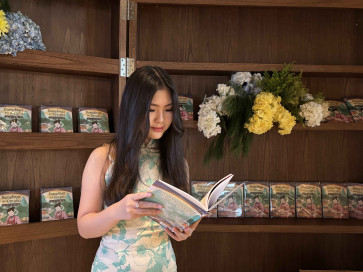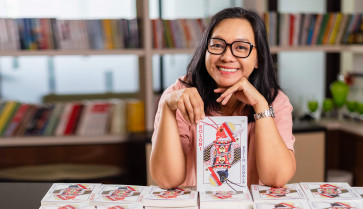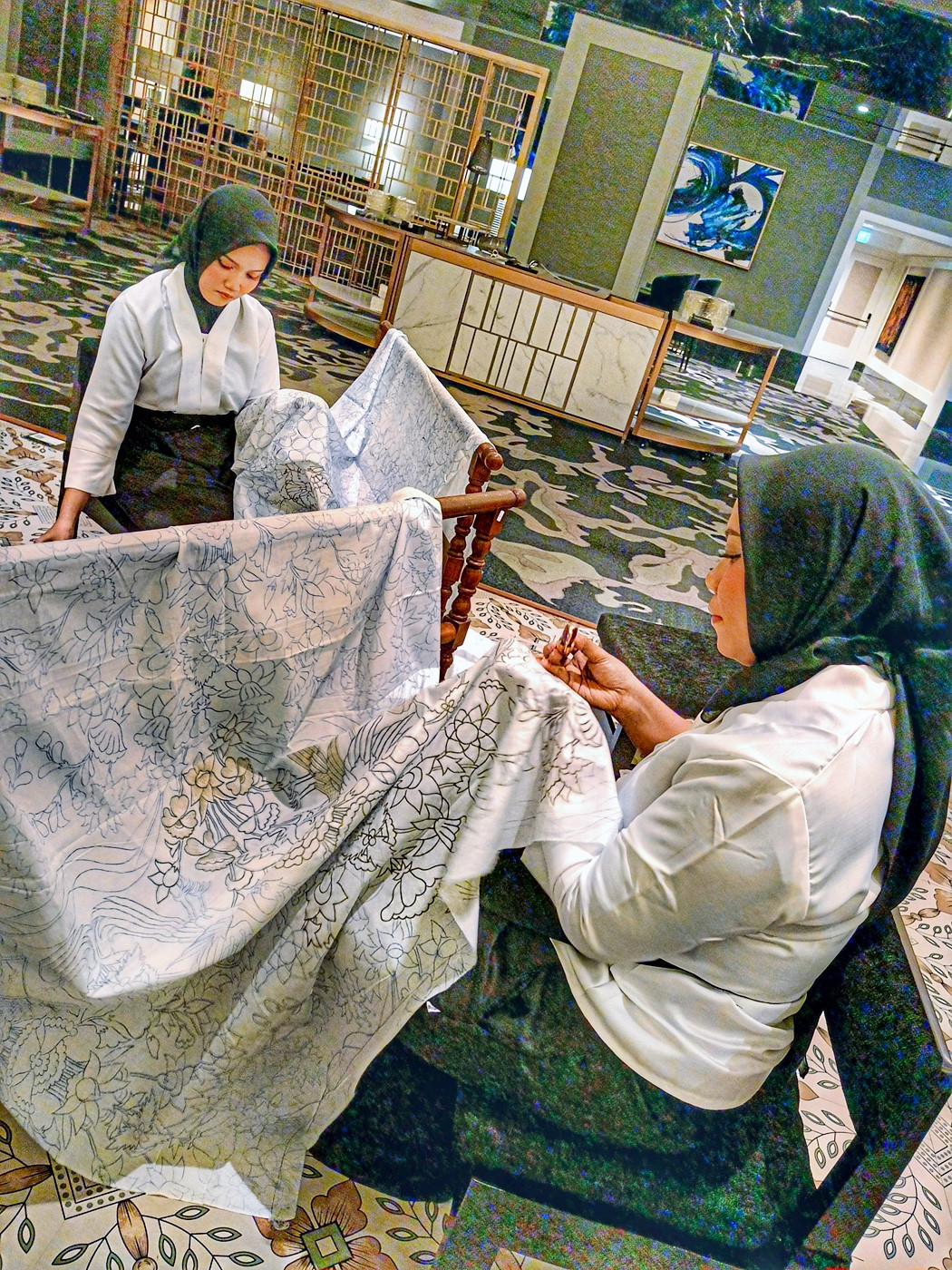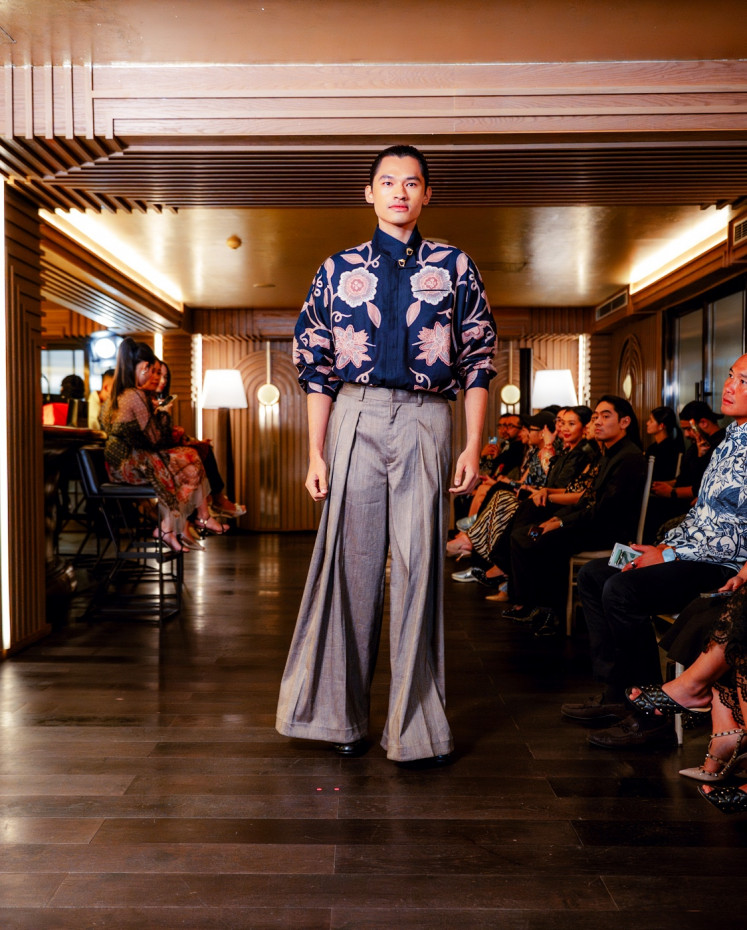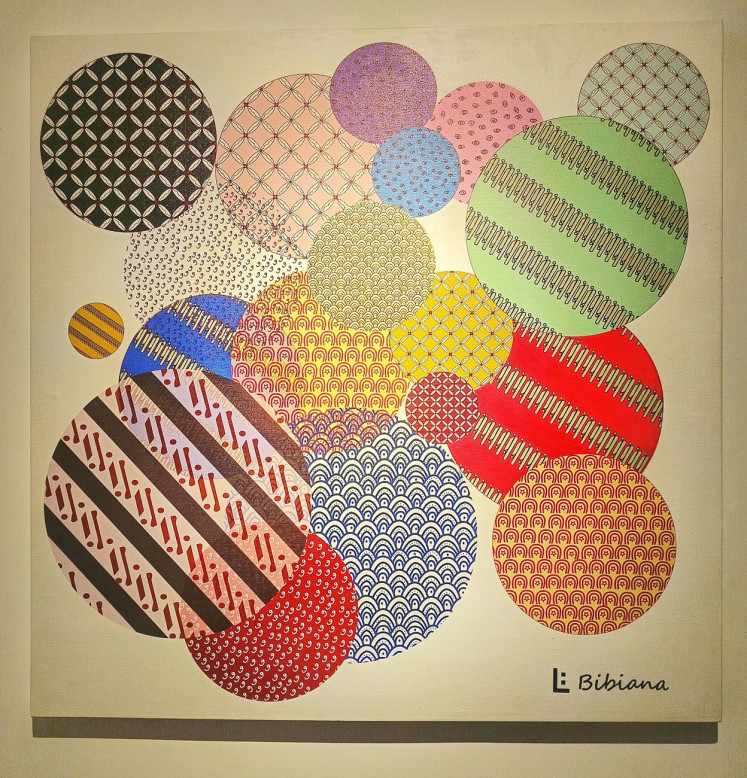Seated on low stools, Ika and Dyah gracefully scoop hot wax with a canting and trace intricate patterns onto pristine white fabric. Their movements are precise yet fluid, resembling an ancient dance passed down through generations.
In late November, in the foyer of St. Regis Jakarta, I was mesmerized as I watched these artisans from the Iwan Tirta Private Collection meticulously bring delicate floral motifs to life.
A model presents a stunning batik shirt by Iwan Tirta Private Collection, adorned with floral motifs. At a closer look, micro-patterns intricately fill the larger designs, adding depth and vitality to the batik. (Courtesy of Iwan Tirta Private Collection)
“It usually takes five to six months to complete a piece of batik,” Ika said, her hands steady as she worked.
The process begins with an intricate drawing that can take weeks, followed by cycles of dyeing, boiling to remove the wax and sun-drying, all of which is repeated multiple times for complex designs.
Dyah, 24, is one of the few Gen Z artisans at the brand’s Pekalongan factory.

Thank you!
For signing up to our newsletter.
Please check your email for your newsletter subscription.
“Not many young people want to do this work; it’s hot, messy and tough,” she admitted.
Artisans spend long hours near heaters to keep the wax molten, their hands often stained by the dyes they work with.
But Dyah has no regrets. “I hope more young people take up the craft and keep it alive,” she said.
Today's young people shouldn't just wear batik but truly understand the legacy they're inheriting. - Bibiana Lee
Later that evening, their hard work was on full display on the runway.
The 2025 Mahitala collection, Sanskrit for “Great Earth”, featured oversized motifs from Sulawesi’s birds to the Sumatran tiger, adorning coats, tailored shirts and elegant evening gowns. Each piece, with its gradient hues and intricate patterns, was a testament to masterful craftsmanship.
This seamless blend of tradition and modernity has resonated with younger generations, now making up nearly half of Iwan Tirta Private Collection’s clientele.
“We want to ensure batik remains relevant and cherished for generations to come,” said Rindu Melati Pradnyasmita, the brand’s head of marketing.
It’s a relevant ambition because, despite batik’s popularity, challenges remain.
Facing modern challenges
Batik’s roots can be traced back to Java’s royal courts in the 13th century, with patterns reflecting social hierarchies, beliefs and nature. Traditionally used as lower garments, batik gained new life in the 1970s when Jakarta Governor Ali Sadikin popularized long-sleeved batik shirts as formal wear.
Bibiana Lee’s mixed-media painting, Then and Now (2024), explores the evolution of traditional batik motifs like Kawung and Parang, reimagining their shapes and colors over time. This piece was part of her solo exhibition at Art:1 New Museum, Jakarta, from Nov. 9 to Dec. 9, 2024. (Courtesy of Sylviana Hamdani)
“From that point, batik evolved into the versatile fashion we see today,” said Hilmar Farid, Indonesia’s director general of culture.
UNESCO's 2009 recognition of batik sparked nationwide pride, but also unleashed a flood of counterfeit Chinese textiles.
“Chinese polymicro textiles, sold for just Rp 15,000 [93 US cents], can replicate any batik motif,” said Komarudin Kudiya, chairman of the Indonesian Batik Foundation experts council and chairman of the Indonesian Batik Artisans and Entrepreneurs Association (APPBI).
To combat this, the Industry Ministry introduced the Batik Mark Indonesia label for authentic batik, though fewer than 1,000 of the nation’s approximately 20,000 batik entrepreneurs have adopted it.
“We’ve urged the People’s Representative Council to draft legal protections for the industry,” Komarudin said, “but we’re still waiting.”
Innovating tradition
Fortunately, batik artisans are not just waiting for government support. Instead, they’re innovating to address modern challenges.
In 2014, Komarudin partnered with engineers from Bandung Institute of Technology (ITB) to create the Fotonik Batik machine, which uses ultraviolet light to set certain colors, reducing reliance on sunlight.
In 2022, he introduced the Batik Pendulum technique to address a post-pandemic labor shortage. This innovation uses a swinging steel funnel to drip hot wax, creating intricate spiral patterns while preserving the dye-resist artistry of traditional batik. Regions like Serang, Blitar, Kediri and Jambi have embraced this technique, revitalizing the craft.
But batik’s environmental impact remains a pressing concern. Many artisans still use chemical dyes, and untreated wastewater pollutes rivers, especially in Pekalongan, a major batik hub.
While some artisans rely on makeshift biofilters, these often leave water tinted. Communal treatment facilities exist in cities like Solo and Yogyakarta, but high costs and logistics make them impractical for many.
In early 2024, Komarudin introduced Alimba, a portable wastewater treatment tool. The device produces clear water with safe Biochemical Oxygen Demand and Chemical Oxygen Demand levels.
“I’ve been using the treated water to raise fish for four months now, and they’re thriving,” Komarudin said, adding that it is also suitable for washing and general cleaning.
Currently, 21 batik entrepreneurs in Cirebon use Alimba in their production.
“As batik entrepreneurs, it’s our responsibility,” Komarudin emphasized.
“We can’t leave a polluted Earth for future generations.”
Expanding the craft
Ensuring batik’s future also means training new artisans and expanding its applications. Advocates are introducing batik to new regions and exploring its use beyond fabric.
“We’ve now expanded batik-producing regions from just five to 27,” said Sendy from the West Java Batik Foundation (YBJB), which has organized workshops and other initiatives since 2008.
“Each region developed unique motifs reflecting local culture and nature,” she added.
For example, Batik Lokatmala in Sukabumi incorporates motifs like kendi (earthen jug), nutmeg and traditional dances to highlight local heritage.
“Batik is a medium for me to encapsulate Sukabumi’s cultural and natural treasures,” said founder Fonna Melania.
Batik also extends beyond clothing. In Krebet Village near Yogyakarta, artisans apply batik techniques to wood, creating items like trays, placemats and utensils. These are now exported to Malaysia, Singapore and Japan.
“The craft is now a main source of income for our village,” shared Putro Dunung, a representative of Krebet, noting that 56 small and medium enterprises (SMEs) rely on the craft.
Artists are also preserving batik through contemporary expressions. At her recent exhibition at the Art:1 New Museum in Jakarta, Bibiana Lee showcased mixed-media paintings featuring traditional batik patterns.
“It’s fascinating how every motif carries a message,” Bibiana said.
“Yet, many young people today are unaware of their meanings.”
A batik future
Global brands are also embracing batik. French audio company Devialet recently collaborated with Sejauh Mata Memandang to create hand-drawn batik covers for their high-end speakers. Made from upcycled fabrics, the covers feature motifs like Semanggi (clover) symbolizing Jakarta’s identity as a metropolis.
Sejauh Mata Memandang's creative director, Chitra Subyakto, adjusts a batik cover on Devialet's Phantom speaker. The cover features Semanggi (clover) patterns, symbolizing Jakarta as a thriving metropolis. (Courtesy of Devialet)
“Batik is a masterpiece that represents Indonesia and elevates it globally,” said Freddie Beh, co-founder of Metrox, Devialet’s distributor in Indonesia.
But as batik evolves, I’m reminded that we have a shared responsibility to keep it not just relevant, but also authentic.
“Today’s young people shouldn’t just wear batik, but truly understand the legacy they’re inheriting,” Bibiana said.
That shared responsibility also includes the government, which “must take stronger measures to protect and nurture the country’s batik industry”, emphasized APPBI’s Komarudin.
Through innovation and collaboration, batik can bridge tradition and modernity while preserving its cultural soul.
Sylviana Hamdani is a journalist with a passion for art, fashion and culture. An adventurer at heart, she explores human creativity and stories through her writing and photography.






